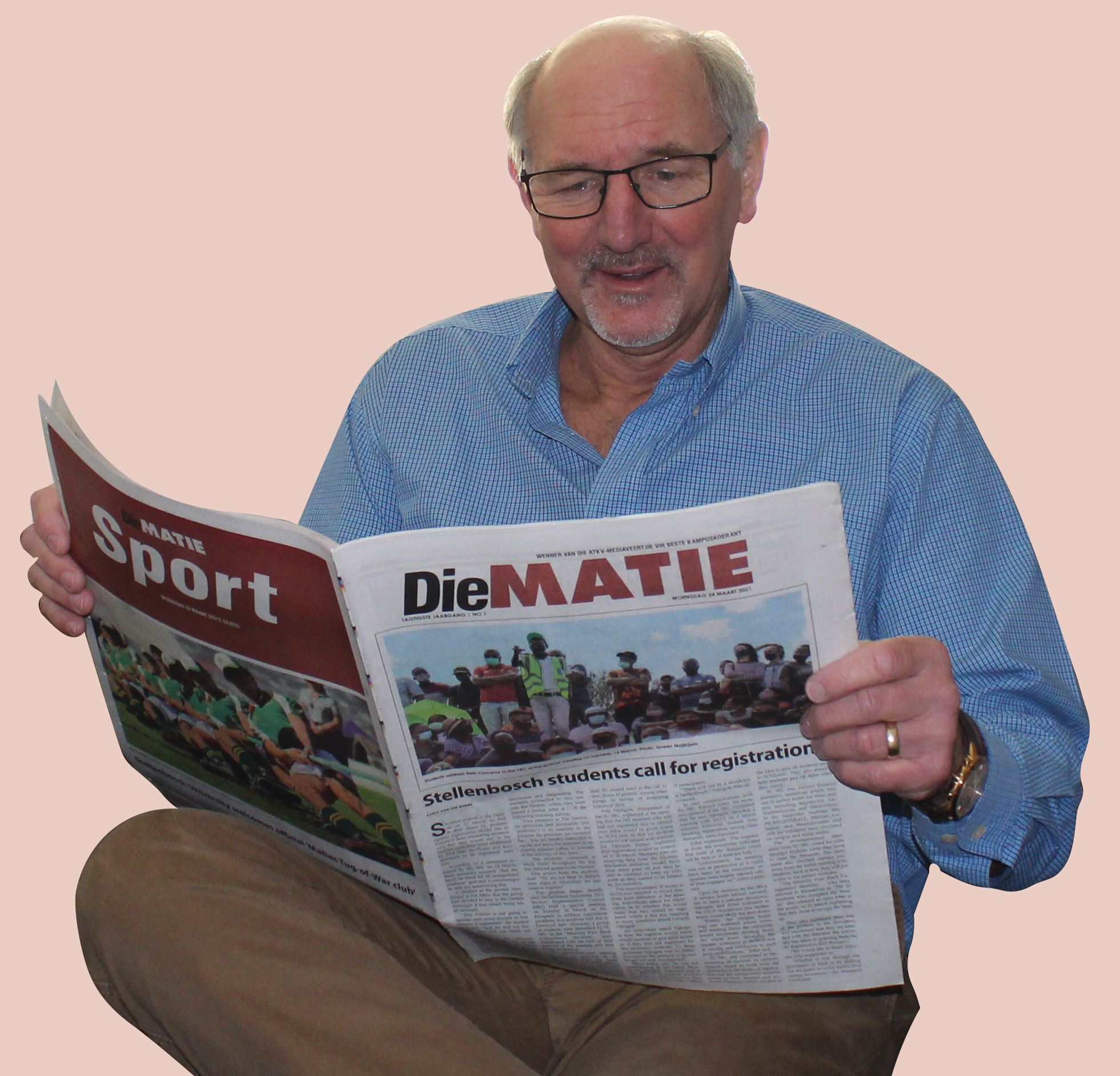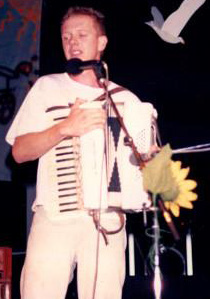BY AURELIA MOUTON
Copies of Die Matie were defaced and scattered around Stellenbosch University (SU) after the publication of a front-page photograph that featured two men kissing at the annual Soen In Die Laan (“Kiss in the Avenue”) event on 30 July 2010.
This frontpage from the August edition of Die Matie made national headlines. It sparked debate and campus-wide commotion, with some outraged parties going as far as slandering and intimidating journalists. However, the front page was also met with support and praise, encouraging and uplifting a community long ignored by its peers.
“I never realised the impact it would have, to be honest. I knew it would fluff a few feathers, but the fact that it created so much liberation for so many people was a definite highlight,” said Vanessa Smeets, former photo editor (2010-2011) of Die Matie and photographer of the renowned photo.
The kissing event formed part of what was known as “Matie Week”,a week-long fundraiser hosted by the SU Student Representative Council (SRC). Lesbigay, SU’s Pride Society, had invited students from the University of Cape Town (UCT) and the University of the Western Cape (UWC) to join them at the event in solidarity, as many queer students had felt intimidated by the mostly heterosexual crowd. The two men in the photograph were identified as UCT students, Bjorn Czepan and Mark Dean Brown.
“The photo actually magnified the blatant homophobia on campus not only from white Afrikaans males but most males of any culture. It was clear to me then that we (Die Matie) had stirred a hornet’s nest and this is what journalism thrives on: to seek the truth and to be the watchdog of society. More stories were soon revealed: the cyberbullying of gay people and gay shaming in public. The gay community hung out in crowds to feel safer,” said Smeets.
The photo evoked a wildfire response from conservatives and appalling homophobic backlash. Some went as far as using the photo as a dartboard, or taking multiple papers from the stand to throw in the bin.
Several news outlets reached out to SU and Die Matie. The photographer, Smeets, as well as the “kissers”, were approached for interviews. The online response to the picture was largely positive if somewhat sensationalised.
Amidst the public controversy, Smeets was met with backlash in her personal life.

WILDFIRE RESPONSE Vanessa Smeets with her photo at the Nelson Mandela Foundation Exhibition. Photo: Supplied
“Personally, I was quite disappointed by some of my friends and the church I was attending at that time. I was ostracised and treated differently. I was also victimised at the commune where I lived, where two boyfriends of my housemates left vicious notes under my door or defaced the paper and left it for me to see on the kitchen counter with [slurs] written in marker and one of the ‘kissers’ changed into a girl,” Smeets continued.
After the publication of the photograph, many closeted students came out. Some even contacted and befriended Smeets to thank her. The internationally recognised photograph has been integral to increasing queer visibility at SU and in South Africa.
According to Smeets, the greatest honour from this photo was being part of the Nelson Mandela Foundation’s exhibition in 2019 called “Insurgent Citizens: protests in a post-democratic South Africa”.
“The opening day was on Human Rights Day and was dedicated to photojournalism that shifted human rights in our country. My particular photo sparked more than just a debate, it led to a whole new conversation about fear, abuse and living in the shadows of who you really are,” said Smeets.
Queer visibility on campus, as well as the integration of queer persons into non-queer spaces, remains one of the most divisive topics at SU. Viwe Kobokana, chairperson of the Transformation Committee of the SRC, believes that SU is welcoming of the LGBTQIA+ community, but does not believe it is a truly safe space for all queer people.
“I have always been open about the fact that I think that the Welcoming Week is not used as optimally as it could be in educating newcomers about topics that may have been taboo in their homes, such as the LGBTQIA+ community. How the conversations are had is still up to the community leaders. However, I believe we need to be more assertive in ensuring that all communities are educating their constituencies on social issues. These sessions are the foundation of open and safe conversations between queer students and allies, and apathetic cis-het students,” Kobokana said.
In an edition of Die Matie from last year, journalist Brynley van Aardt covered allegations of homophobia and queerphobia against queer persons in leadership in Wilgenhof. This is the former residence of current SU Chancellor, Justice Edwin Cameron. Cameron, also a former member of the Die Matie editorial team, tells of his years (1972-1976) as a closeted student at SU.
“As was the political and religious climate in Stellenbosch at the time, it was a deeply homophobic environment. During my time at Wilgenhof, I only had one friend to whom I had come out. Through covert messaging, we had both discovered we were gay men.”
Speaking about his time as Prim of Wilgenhof, Cameron said that he was not proud of those years he spent as a repressed queer man.
“I feared exposure, so I avoidedany political engagements. I was a ‘mak Engelsman’. Hiding was accessory to lack of political courage,” he continued.
Cameron, a retired justice of the Constitutional Court of South Africa, was amongst those who participated and spoke at South Africa’s first-ever Pride march on 13 October 1990. The event was not merely a march, but also a demonstration against apartheid and the discriminatory laws of South Africa at the time.
“When I came out, it was a release of not only personal energy, but also political energy, and of courage,” said Cameron.
During the Covid-19 pandemic in 2020, the QueerUS Society celebrated its first virtual Pride month, in collaboration with other Pride societies from various universities in South Africa. This year international Pride month was celebrated on campus by residences raising the rainbow Pride flag outside their buildings.
“I feel like a lot of people discovered their identities in lockdown when we were forced to isolate and learn more about ourselves. Now we have a lot of people coming out of the closet. But, don’t feel pressure to be public with your identity. Whether you are the most visibly queer person or you are the only one who knows, your identity is valid. In a perfect world, we would all be living in a society where we can live openly and freely. I hope that we’re on the way there,” said Mardene van Schalkwyk, a second year BA (Visual Communication Design) student.
Alex Vink, a final-year LLB student, believes that if minority groups are afforded a chance to succeed and the right tools and resources, positive change will happen. Positive change can be made and can occur constantly, in all spheres – not only those that are queer-related.
“What I think has shaped and will always shape Queerdom at SU is the queer individuals on campus, who don’t necessarily choose to, but still boldly represent queer culture and our community. Those who tend not to even be in leadership, but who walk in their queerdom and express themselves fearlessly everyday. They are the ones who, even if unintentionally, make the political statement of ‘We’re here, we’re queer!’,” said Vink.
This article is dedicated to Bjorn Czepan, who passed away shortly after the publication of the Soen In Die Laan photo. It is also dedicated to Lincoln Loxton, who was an incredible ambassador for LGBTQIA+rights on MFM and at SU.
*LGBTQIA+ refers to persons of lesbian, gay, bisexual, transgender, queer, intersex, asexual and other sexual orientations.



